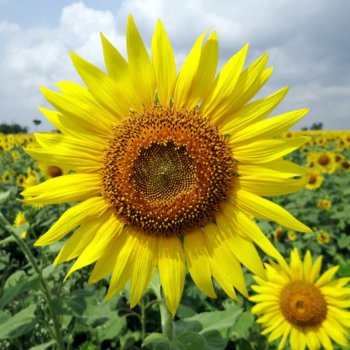Changing trends in planting design – where to from here?

At GLAS 2018, Patricia Tyrell of the Garden and Landscape Designers Association presented her discussion on the changing trends of planting design.
31 July 2018
Having initially studied Landscape Horticulture, also at UCD, Patricia Tyrell launched her own Design Consultancy Business in 84, and has completed many assignments in the Commercial and Residential sectors.
As a qualified Landscape Horticulturist, Tyrell believes strongly that good landscape design should be underpinned with good planting design, and offers a specialist service in planting design to clients with existing gardens in need of renewal and to other design professionals.
At GLAS 2018, Tyrell presented her discussion on the changing trends in planting design. Check out her presentation below.
What are the key forces that have driven change in the past?
- Maintenance – Labour and skills available.
- Technology – mechanisation, herbicides, plumbing.
- Major world events – war, famine, environment.
- History/Literature.
Man Power
- Labour readily available and cheap before the First World War. Gardens therefore intensively managed.
- Associated with wealth.
- Herbaceous borders.
- Exotic Fruits/Vegetables.
- After the war labour was scarce. Swing away from high maintenance.
- Now labour costs high and skilled labour difficult to source.
- Decline in herbaceous borders, formal gardens.
The Rise of the Lawn
- First lawnmower was invented in 1830 by Edwin Beard Budding an engineer from Gloucestershire.
- He got the idea after seeing a machine in a local cloth mill which used a cutting cylinder mounted on a bench, to trim cloth to make a smooth finish after weaving..
- He went into partnership with a local engineer, John Ferrabee and together they made mowers at a factory in Stroud.
- Motorised mowers appeared in the 1890’s.
Flowery Meadows
- Before lawnmowers, lawns were trimmed with a scythe and were a mixture of grasses and flowers.
- Move back to wildflower meadows as more resilient to drought and less inputs.
Lawnmower availability
- Lawnmower ownership initially the domain of the privileged.
- Poorer people had cottage gardens – plants from seeds, cuttings, fruit and vegetables.
- After World War 1 there was an unprecedented growth in lawnmower production.
- People moving to new sub-urban housing with small gardens.
- Mass production lead to cheaper mowers.
- The Lawn became king.
Chemical weed control
- Prior to herbicides mostly mechanical control – labour intensive.
- First herbicide introduced in 1940 2,4,-D.
- Herbicides brought with them the fashion for “ground cover” shrubs – usually a handful of species that would cover the ground and were resistant to weedkiller.
- This excluded perennials as ornamentals.
- This style of planting still persists in Ireland
The Rise of The Perennial
- Realisation that shrubs on their own are uninteresting and an unnatural arrangement.
- Major movement towards a more natural style of gardening.
- Influences from nurserymen who realised the potential of perennials for colour and interest.
- The New Perennial Movement
Environmental Awareness
- Present day fashion for more natural plantings driven by a desire to:
- Reduce the use of chemicals.
- Increase biodiversity.
The New Perennial Movement
- William Robinson “The Wild Garden” 1870.
- 1990 Wolfgang Oehme and James Van Sweden “The Bold Romantic Garden”.
- Use of perennials inspired by wild and prairie landscapes – mix of grasses and perennials.
- The Dutch Wave or New Perennial Movement Piet Oudolf being the most well known proponent of this style.
- It seeks to minimise inputs such as herbicides, fertilisers and to encourage wildlife and biodiversity.
- Different from other planting styles is that instead of planting in monocultural blocks, perennials and grasses are freely intermingled in single and small groups to create natural-looking drifts and repeated patterns throughout the entire planting area.
The Layered Landscape
- Plants sharing a common habitat are grown in layers from bulbs to herbaceous layer, shrubs and trees.
- Increased colour and interest.
- Increased biodiversity.
- More moisture retention.
Current forces influencing trends
- Lack of consumer knowledge.
- Lack of horticultural skills for planting/maintenance.
- Urbanisation- moving away from tradition/collective knowledge.
- Smaller gardens/spaces –fitting it all in.
- Less home ownership – pots/containers.
- More environmental awareness, concern for the natural world.
- Climate – drought/ wet cycles.
- Flood reduction – Green roofs, walls, SUD’s, Rain gardens, less hard surfaces.
- Increased plant varieties available.
- Major world events – war, famine, loss of habitat, reduced resources.
Current and Predicted Trends
- Gardening with Less Space.
- Small specimen trees – Acers, Amelanchier, Malus.
- Shrub specimens grown as trees.
- Plants with multiple seasons of interest.
- Pleached trees will continue to be popular but with increased demand for more variety and less vigorous.
- Less formality – box edging.
- Container gardening.
- Interesting annuals – Salvias, Sunflowers.
- Focus on layers – bulbs, perennials, grasses, shrubs and trees.
- More natural looks – habitats – woodland, wildflower meadows.
- Fruiting and native trees for wildlife and people.
Stuck in time
- Ireland behind the curve in terms of trends.
- Older demographic interested in gardening – traditional approach.
- Younger home owners attracted by more modern styles of gardening but unsure how to achieve it or maintain it.
- Perceive designers as too expensive.
- Mistakenly perceive modern styles as high maintenance.
- Often strongly influenced by landscape contractors as to what is planted. – Photinia Red Robin, shrubberies.
- Increase in hard landscaping as its perceived as lower maintenance and requires less knowledge.
My future Wish List
- More science and horticulture education needed at a much younger age – primary school.
- Giving people the knowledge and confidence to be more adventurous.
- Educational, forward thinking, plant focused garden programme – homegrown.
- Availability of a greater variety of plants and demonstration of plant combinations in Garden Centres.



 Print
Print








Fans 0
Followers